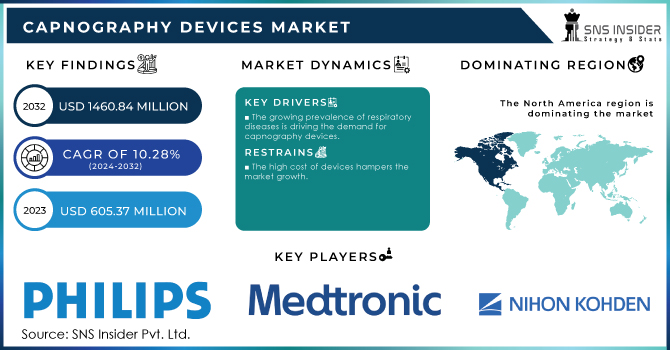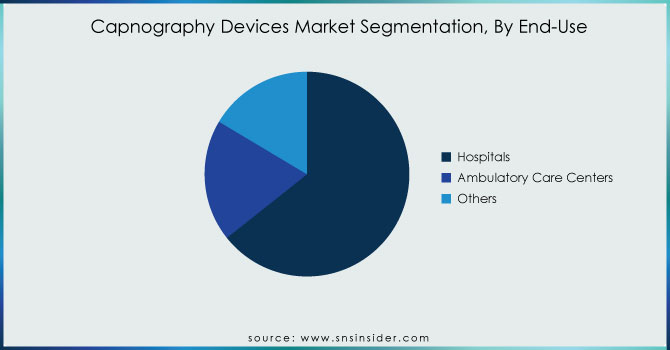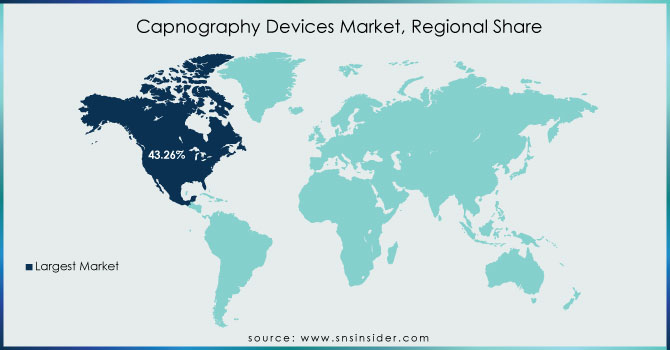Capnography Devices Market Size & Trends
The Capnography Devices Market size was valued at USD 605.37 million in 2023 and is expected to reach USD 1460.84 million by 2032 and grow at a CAGR of 10.28% over the forecast period 2024-2032.

Get more information on Capnography Devices Market- Request Free Sample Report
There is a noticeable trend in the surgical procedural field, particularly in general anesthesia, toward the adoption of capnography devices; which are designed to monitor patients’ status regarding ventilation. According to the U.S. Centers for Disease Control and Prevention, in the United States, annually approximately 48 million surgical procedures are conducted and an overwhelming proportion of them employ general anesthesia. Capnography devices are increasingly integrated into operating rooms to provide the continuous monitoring of end-tidal carbon dioxide, which is one of the critical parameters for assessing a patient’s ventilation during anesthesia. Their use helps anesthesiologists to discover hypoventilation, airway obstruction, and other developing respiratory problems timely, therefore, reducing the risk of adverse development.
The recommendation by various health organizations, including the American Society of Anesthesiologists, to use capnography during moderate and deep sedation is significantly driving the demand for these devices in the healthcare market. The ASA, in its practice guidelines, emphasizes the importance of continuous monitoring of end-tidal carbon dioxide levels to enhance patient safety during sedation.
Moreover, this is particularly crucial as capnography provides real-time data on a patient’s ventilatory status, allowing for the early detection of respiratory depression or airway obstruction. According to the U.S. Department of Health and Human Services, millions of procedures involving moderate to deep sedation are performed annually across the United States. The HHS has also highlighted that the adoption of capnography in these settings has been shown to reduce the incidence of sedation-related complications, leading to improved patient outcomes.
Furthermore, the rising prevalence of respiratory diseases like chronic obstructive pulmonary disease and asthma is significantly boosting the demand for capnography devices, as these conditions require continuous and accurate respiratory monitoring.
Capnography Devices Market Dynamics
Drivers
The growing prevalence of respiratory diseases is driving the demand for capnography devices.
The consumption volume of capnography devices is significantly high owing to the increased prevalence of respiratory diseases. Respiratory diseases need precise and continuous monitoring of the patient’s respiratory function. The World Health Organization has warned that chronic respiratory diseases including chronic obstructive pulmonary disease and asthma are among the top leading killers of people globally. Centers for Disease Control and Prevention in the United States revealed that close to 16 million Americans are suffering from chronic obstructive pulmonary disease and many remain undiagnosed or are at a higher risk. This means that most of these patients need capnography devices to monitor their respiratory levels. Therefore, the demand for capnography devices that provide real-time readings of end-tidal carbon dioxide has continued to grow as hospitals and clinics aim to facilitate the management of the conditions. The device measures the EtCO levels that are an indication of respiratory distress. Therefore, the devices help to monitor the level of functions of the disease by taking real-time measurements.
Restrain
The high cost of devices hampers the market growth.
The high cost of capnography devices is one of the main reasons, the implementation of this technology remains limited. Moreover, if some capnography devices are equipped with advanced features, such as real-time data analytics, and integrated monitoring systems, this may raise the price of the devices even more. Besides, many healthcare facilities, such as small rural hospitals, and clinics or hospitals in developing countries, already run on very limited budgets, and, for them, purchasing such a device will be unjustifiable. Moreover, in both well and sub-developed countries, it is important to constantly pay for the maintenance of the devices, as well as their recalibration, which is also expensive.
Capnography Devices Market Segmentation Analysis
By Type
The hand-held segment held the largest market revenue share of 62.6% in 2023. The hand-held capnography devices are important for monitoring CO2 levels and ensuring patient safety, leading to their increased adoption due to their portability, along with versatility, which makes them ideal for critical care across various medical settings such as hospitals, clinics, or ambulances. The ease of use also contributes to their popularity across different healthcare settings to support critical care delivered in anesthesia, sedation, or emergency scenarios.
The multi-parameter segment is expected to witness the fastest growth over the forecast period. Advances in sensor technology, data integration, and non-invasive monitoring have increased the accuracy, as well as usability of multi-parameter capnography devices, resulting in their increased adoption in critical care and anesthetic settings.
By Technology
The side stream segment dominated the largest market revenue share of 55.2% in 2023. The side-stream technology is increasingly employed in anesthesia monitoring and is resulting in remarkable growth. The device integrated with this technology is connected via an extend-life proprietary connector, situating the infrared source away from the external environment. This ensures a reduction in the challenge of sterilization. In addition, to detect critical health conditions such as hyper or hypothermia, a highly accurate and durable sensor is required. For example, incorporating advanced infrared absorption spectroscopy, the LoFlo sidestream sensor from Philips Respironics ensures precise respiration rate and EtCO2 measures bright, clear programs even at respiratory rates as high as 150 breaths per minute.
By Application
The largest market revenue share of 24.0% in 2023 was held by the emergency medicine segment. Emergency medicine that includes acute care in the field of obstetric, medical, and surgical emergencies is associated with considerable growth in the emergency medical services segment. Capnographs are increasingly used to guarantee optimized prehospital ventilation and pediatric emergency management. Additionally, the devices are used to evaluate the adequacy of pulmonary blood flow. It should be noted that the growing incidence of trauma cases that require prompt provision of medical services also fosters the growth of this healthcare segment. According to the American Association for the Surgery of Trauma, trauma becomes a cause of death for every second person under the age of 45. It is the fourth leading cause of death across all age groups.
By End-Use
The hospitals segment is attributable to the largest market revenue share of 64.32% in 2023. This was due to the higher capability of patient monitoring, a higher number of ventilation measurement systems available, and the higher adoption by the facilities. The market is expected to grow due to the increasing number of surgeries and the high prevalence of lifestyle disorders, such as diabetes, and respiratory diseases like asthma, among others. Additionally, the availability of state-of-the-art infrastructure in hospitals in developed countries is likely to boost the segment growth.

Get Customized Report as per your Business Requirement - Request For Customized Report
Capnography Devices Market Regional Insights
North America capnography devices market dominated the market in 2023 with around 43.26% of the market share. This is increasing due to the unhealthy lifestyles and high levels of stress, respiratory disorders are becoming more common, which has a significant impact on the area market. Moreover, the incorporation of new reimbursement models for respiratory and monitoring solution procedures in this region and stringent regulatory guidelines focused on patient safety and medical efficacy, and clinical efficiency are expected to drive the product demand in the future. According to the 2020 survey by the American Psychological Association, increased stress negatively affected 49% of U.S. adults’ behavior in 2020 and increased bodily tensions in 21%.
Asia Pacific is the fastest-growing region in the capnography devices market. This is due to high sedentary lifestyle trends, increasing geriatric population, rising prevalence of target disease, and increasing prevalence of smoking are further anticipated to drive the growth.

Capnography Devices Market Key Players
The major players listed in the capnography devices market are Masimo, Koninklijke Philips N.V., Medtronic, Nihon Kohden Corporation, Nonin, Diamedica (UK) Limited, EDAN Instruments, Inc., Dragerwerk AG & Co. KGaA, Dow Inc., Baxter, and others.
Recent Developments in the Capnography Devices Market
-
In 2023, Philips broadened its portfolio by updating and providing the Respironics NM3, a portable ventilator, with capnography integrated. The integrated capnography helps monitor the patient’s respiratory status more easily than before, especially in intensive care units.
-
In 2023, Masimo launched Masimo Opioid Halo, a new wearable device that combines continuous capnography and pulse oximetry with its Opioid Dose Advisory technology developed to monitor patients at risk patient for opioid-induced respiratory depression to enhance patient safety by continuously monitorization of their ventilation and oxygenation.
| Report Attributes | Details |
|---|---|
| Market Size in 2023 | US$ 605.37 Million |
| Market Size by 2032 | US$ 1460.84 Million |
| CAGR | CAGR of10.28 % From 2024 to 2032 |
| Base Year | 2023 |
| Forecast Period | 2024-2032 |
| Historical Data | 2020-2022 |
| Report Scope & Coverage | Market Size, Segments Analysis, Competitive Landscape, Regional Analysis, DROC & SWOT Analysis, Forecast Outlook |
| Key Segments | • By Type (Hand-Held, Stand-Alone, Multi-Parameter) • By Technology (Mainstream, Sidestream, Microstream) • By Application (Emergency Medicine, Pain Medicine, Procedural Sedation, Critical Care, and Others) • By End-Use (Hospitals, Ambulatory care, and Others) |
| Regional Analysis/Coverage | North America (US, Canada, Mexico), Europe (Eastern Europe [Poland, Romania, Hungary, Turkey, Rest of Eastern Europe] Western Europe] Germany, France, UK, Italy, Spain, Netherlands, Switzerland, Austria, Rest of Western Europe]), Asia Pacific (China, India, Japan, South Korea, Vietnam, Singapore, Australia, Rest of Asia Pacific), Middle East & Africa (Middle East [UAE, Egypt, Saudi Arabia, Qatar, Rest of Middle East], Africa [Nigeria, South Africa, Rest of Africa], Latin America (Brazil, Argentina, Colombia, Rest of Latin America) |
| Company Profiles | Masimo, Koninklijke Philips N.V., Medtronic, Nihon Kohden Corporation, Nonin, Diamedica (UK) Limited, EDAN Instruments, Inc., Dragerwerk AG & Co. KGaA, Dow Inc., Baxter, and others. . |
| Key Drivers | •The growing prevalence of respiratory diseases is driving the demand for capnography devices. |
| RESTRAINTS | •High cost of devices hampers the market growth. |

